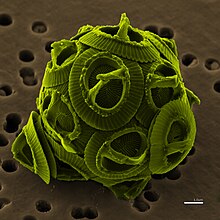
Coccolithophores, or coccolithophorids, are single-celled organisms which are part of the phytoplankton, the autotrophic (self-feeding) component of the plankton community. They form a group of about 200 species, and belong either to the kingdom Protista, according to Robert Whittaker's five-kingdom system, or clade Hacrobia, according to a newer biological classification system. Within the Hacrobia, the coccolithophores are in the phylum or division Haptophyta, class Prymnesiophyceae. Coccolithophores are almost exclusively marine, are photosynthetic, and exist in large numbers throughout the sunlight zone of the ocean.

The haptophytes, classified either as the Haptophyta, Haptophytina or Prymnesiophyta, are a clade of algae.

Fucus vesiculosus, known by the common names bladderwrack, black tang, rockweed, sea grapes, bladder fucus, sea oak, cut weed, dyers fucus, red fucus and rock wrack, is a seaweed found on the coasts of the North Sea, the western Baltic Sea and the Atlantic and Pacific Oceans. It was the original source of iodine, discovered in 1811, and was used extensively to treat goitre, a swelling of the thyroid gland related to iodine deficiency.

Coccoliths are individual plates or scales of calcium carbonate formed by coccolithophores and cover the cell surface arranged in the form of a spherical shell, called a coccosphere.

Emiliania huxleyi is a species of coccolithophore found in almost all ocean ecosystems from the equator to sub-polar regions, and from nutrient rich upwelling zones to nutrient poor oligotrophic waters. It is one of thousands of different photosynthetic plankton that freely drift in the photic zone of the ocean, forming the basis of virtually all marine food webs. It is studied for the extensive blooms it forms in nutrient-depleted waters after the reformation of the summer thermocline. Like other coccolithophores, E. huxleyi is a single-celled phytoplankton covered with uniquely ornamented calcite disks called coccoliths. Individual coccoliths are abundant in marine sediments although complete coccospheres are more unusual. In the case of E. huxleyi, not only the shell, but also the soft part of the organism may be recorded in sediments. It produces a group of chemical compounds that are very resistant to decomposition. These chemical compounds, known as alkenones, can be found in marine sediments long after other soft parts of the organisms have decomposed. Alkenones are most commonly used by earth scientists as a means to estimate past sea surface temperatures.

Richard Albert Mohler Jr. is an American evangelical theologian, the ninth president of The Southern Baptist Theological Seminary in Louisville, Kentucky, and host of the podcast The Briefing, where he daily analyzes the news and recent events from an evangelical perspective.
Alkenones are long-chain unsaturated methyl and ethyl n-ketones produced by a few phytoplankton species of the class Prymnesiophyceae. Alkenones typically contain between 35 and 41 carbon atoms and with between two and four double bonds. Uniquely for biolipids, alkenones have a spacing of five methylene groups between double bonds, which are of the less common E configuration. The biological function of alkenones remains under debate although it is likely that they are storage lipids. Alkenones were first described in ocean sediments recovered from Walvis Ridge and then shortly afterwards in cultures of the marine coccolithophore Emiliania huxleyi. The earliest known occurrence of alkenones is during the Aptian 120 million years ago. They are used in organic geochemistry as a proxy for past sea surface temperature.

Armin Mohler was a Swiss far-right political philosopher and journalist, known for his works on the Conservative Revolution. He is widely seen as the father of the Neue Rechte, the German branch of the European New Right.

Chlorodesmis is a genus of green algae in the family Udoteaceae. Algae in this genus produce the toxic diterpene chlorodesmin to defend themselves against generalist herbivores This toxin also kills certain corals that touch the alga. Certain fish like the green coral goby that live in the corals eat the alga to enhance their own toxicity. Other coral dwelling fish like Paragobiodon echinocephalus actively trim the alga even though they don't eat it.

Gephyrocapsa is a genus of haptophytes.
Emiliania is a global coccolithophorid genus.

Ernest Follette "Kid" Mohler was an American baseball player and coach. He played in Major League Baseball (MLB) for three games with the Washington Senators of the National League in 1894. His minor league career stretched from 1890 through 1914, mostly in the Pacific Coast League (PCL), where he played 1,600 games and notched over 1,400 hits. Mohler served as the head baseball coach at the United States Naval Academy from 1929 to 1932, compiling a record of 36–25–1. He was elected to the Pacific Coast League Hall of Fame as part of the 2012 class.
Emiliodonta is an extinct genus of bivalve in the extinct family Praenuculidae. The genus is one of three genera in the subfamily Concavodontinae. Emiliodonta is known solely from late Ordovician, Caradocian epoch, fossils found in South America. The genus contains a single accepted species, Emiliodonta cuerdai.

Gephyrocapsa oceanica is a species of coccolithophorid. It is the type species of the genus Gephyrocapsa. The species is an important Pleistocene biostratigraphic marker.

The 1912 Washington gubernatorial election was held on November 5, 1912. Democratic nominee Ernest Lister defeated Republican incumbent Marion E. Hay with 30.55% of the vote. Lister was voted in with the smallest percentage of the vote in a gubernatorial election in the 1900s.
Maureen Hatcher Conte is biogeochemist known for her work using particles to define the long-term cycling of chemical compounds in seawater.
Reticulofenestra is a genus of haptophytes.









